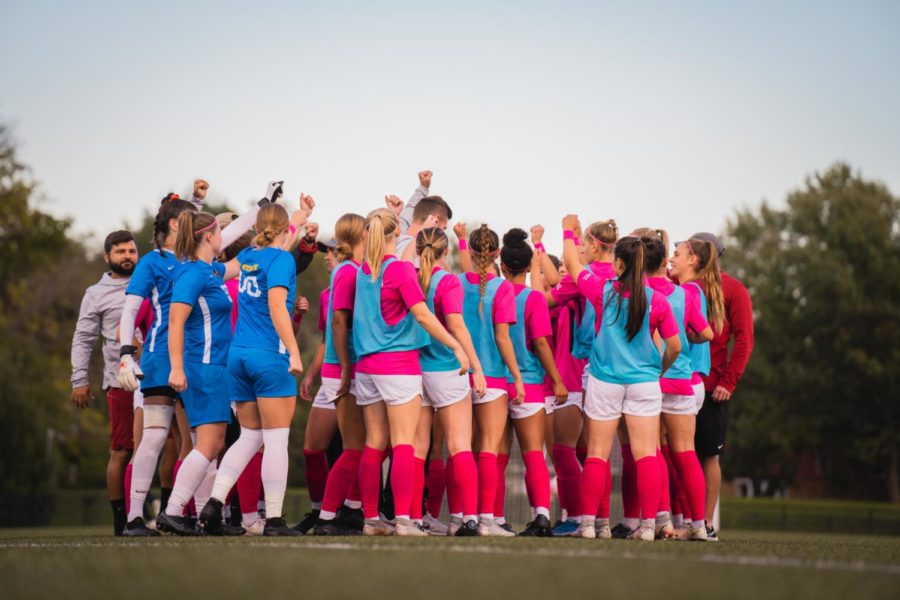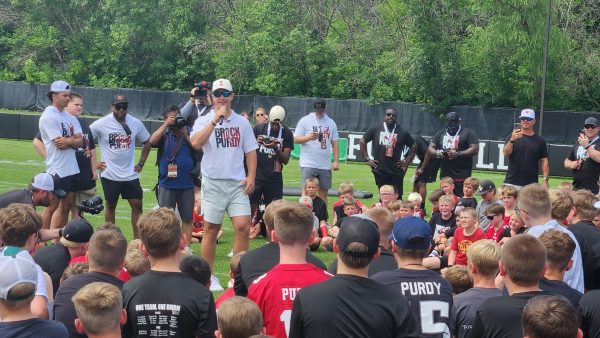Title IX: Soccer and the power of culture
June 30, 2022
Although the Iowa State soccer program has been around for half the time of Title IX, the powerful women who paved the way for the program to succeed helped create a rich history and strong culture that lasts to this day.
As Title IX celebrated its 50th anniversary, the soccer program recently celebrated its 25th anniversary. The soccer team came into existence as the athletics landscape was changing, and they saw the benefits firsthand.
Without Title IX and the strong women who fought for their chance to compete, there would be no soccer team.
Humble beginnings
Soccer was added as a sport in the mid-1990s as collegiate soccer started to take off.
In 1995, Iowa State was looking to add another women’s sport into the mix as female enrollment began to rise. Around the same time, Olympic sports at the collegiate level were beginning to garner more attention.
Colleges were beginning to see the advantages that Olympic sports brought, and it was a no-brainer to add soccer to the list of Iowa State sports at the time. This would also keep Iowa State level with the other Big Eight schools at the time.
Before the Big 12, there was the Big Eight, which was the home of Iowa State athletics before 1996. Also, around that time, the former Senior Women’s Administrator Elaine Hieber was helping figure out how to continue growing the opportunities at Iowa State.
Hieber was a strong advocate for equity in women’s athletics throughout her time working at Iowa State. Title IX got the ball rolling, but there was still work to be done at the time and even today.
The early-1990s saw the rise in popularity of women’s soccer at the collegiate level. At the time, soccer was the fastest-growing program at colleges, according to Hieber.
So in 1995, Iowa State soccer was born. The first was an exhibition year to test the waters before the real deal in 1996.
“Starting was difficult,” Hieber said. “Everything started from ground zero.”
Ground zero is a great way to describe the early days of the soccer program. The Lied Recreation Center was the home to Cyclone soccer at the time, as they had one practice field and one game field to compete on.
In the early years of women’s sports, teams had to share everything. Women had to share uniforms and facilities and even fundraise through bake sales and other methods to come up with the money to travel.
Because there was no men’s soccer team at Iowa State, the women’s team didn’t have to share locker room space, uniforms or game fields. However, what they had at the time wasn’t anything to write home about.
The first field they played on had no lights for night games or permanent bleachers, according to Assistant Athletics Director Lindsey Long, who played soccer for Iowa State in 1999. The bleachers were driven in on trucks on game day.
The Cyclone Sports Complex that opened in 2012 presented many new opportunities for student-athletes at Iowa State. It houses soccer and softball games, as well as track and field competitions.
With lighting and permanent bleachers, the atmosphere around soccer games improved. Night games pull in a different crowd and improve the fan experience. Overall, the growth in resources that soccer has continues to benefit the program today and in the future.
“We had to have that to be where we are today,” Long said. “There were pioneers and trailblazers that paved the way for women in education and women in athletics, that is required to be where we are today.”
Building a strong culture
One goal of the Cyclone soccer program was to build a winning culture. Over the years, the program has become a coaching carousel, but each coach brought their own strengths and cultures to help grow the program to where it is today.
Past athletes still talk about their playing days with pride. Long still remembers the traditions of the coaches in her playing days, like how the team wouldn’t step foot on the game field until it was time to play.
From the time of the program’s birth, it needed someone at the helm who had a strong desire to better the team. The first head coach of Cyclone soccer was Cathy Klein, who Hieber described as a “fiery, aggressive, competitive coach.”
Klein’s strong soccer background helped the program through early growing pains. It wasn’t until 2005 that the Cyclones attended their first and only NCAA appearance under Rebecca Hornbacher.
It takes many years to build a winning culture in a program, and obstacles are expected. The soccer program came into existence at the same time as the Big 12, so they faced strong competition from the start.
“Like any sport, you have to have leadership on the team. You have to,” Long said. “That’s what I enjoy seeing today; Matt Fannon is building that leadership on the team.”
Although the team has seen mixed success throughout the years, Cyclone soccer is still growing and looking toward the future. Fannon has done a great job putting pieces together for future success.
As one of the newer sports on the college scene, soccer is evolving faster than ever. As new coaches come in and build up the culture more, success is going to become more common.
What may have been a dream 25 to 30 years ago is now blossoming into a strong program that should see success for years to come.
“When the culture on the team is strong, you’re going to yield the results,” Long said. “And I think they’re close.”
Impact of Title IX
Title IX has done wonders for presenting young women the opportunities in college athletics.
Soccer came into existence due to the equal funding that men’s and women’s programs need. As men’s sports grow, women’s sports should also grow.
This wouldn’t have been possible if Title IX hadn’t highlighted the big issue in college athletics.
“Title IX brought visibility to discrepancies in opportunities,” Long said.
These discrepancies were clear to see in athletics. Why should men have the opportunity to compete in sports if women could not?
Although athletics saw a huge impact from Title IX, education was another huge aspect of the bill. Everyone should have access to a great education, and athletics can provide that access. Strong women were needed to pave the way for current student-athletes to succeed.
“I would not have had some of those same opportunities if it wasn’t for the women before me,” Long said.
Long came in as a scholarship athlete for a sport she loved, soccer. That wouldn’t have been possible without Title IX.
Education and resources for student-athletes are continuing to get better every year. The existing opportunities wouldn’t have been possible without the tireless efforts of those who pushed for Title IX.
As someone who paved the way for young women, Hieber said it is important to “help females succeed above you.” Setting up the future for success is one of the main ways that women’s athletics continue to grow.
Paving the way is important, but bringing visibility to sports is equally important. Title IX was able to bring visibility to the opportunities for women in athletics, but it also brought media visibility to sports.
As popularity rises around college sports, more networks and media outlets begin to notice.
“I’m from Colorado. My parents could have seen me play without having to be physically here,” Long said. “That was not an option when I was playing.”
It is clear that women’s sports, such as soccer, continue to grow. What the playing conditions were like back in the early years shows how far the programs have come.
From packing in a small van and traveling across the country to flying internationally to big stadiums, women’s sports are trending in the right direction. The Cyclone soccer program is a perfect example of the resources that young women have today that give them the same opportunities as men.
That is thanks to Title IX.
“Without Title IX, we would have these opportunities,” Hieber said. “I wouldn’t have a career without Title IX.”

















